When Convolutional Neural Networks Meet Laser-Induced Breakdown Spectroscopy: End-to-End Quantitative Analysis Modeling of ChemCam Spectral Data for Major Elements Based on Ensemble Convolutional Neural Networks
Abstract
1. Introduction
- Firstly, our model architecture is specially tailored for spectra analysis. Most deep learning models used currently in spectrum analysis employ ANN architectures imported from natural language processing or computer vision, and the details of the model architectures are often random.
- Secondly, unlike most of the data-driven deep learning models, we integrate prior domain knowledge of wavelength interval selection and screening into deep learning to improve the interpretation and robustness of learning systems.
- Lastly, compared with the traditional single modeling method, we provide a further extension by designing an ensemble method that can explicitly exploit the complementary knowledge from various submodels.
2. Materials and Methods
2.1. Basic Principles and Datasets of LIBS
2.2. CNN Modeling and Training Process
2.3. Optimization of the CNN Analysis Model
2.4. Quantitative Prediction Models for Comparison
2.5. Evaluation of the Prediction Model
3. Results
3.1. Comparison of the ECNN Model and the Traditional Chemometric Modeling Method
3.2. Influence of CNN Parameter Values on the Predictive Ability of the Model
3.3. Visualization of Features Extracted by the CNN Network
4. Discussion
4.1. Model Design
4.1.1. Number of Network Layers
4.1.2. Effects of Convolution Kernel Parameters
4.2. Understanding the Models
4.3. Future Development Trends
- Consider the measurement uncertainty that affects the results of the models: In several remote LIBS measurements, such as ChemCam, issues that limit the accuracy and precision of the elemental composition of targets are not necessarily related to the post processing of the data, but in some cases with the experimental conditions [54,55]. The proposed method should be tried out for more than just the chemical matrix effect, such as with different sample states, variable laser-target distances, etc.
- Implement data augmentation algorithms: As demonstrated in the part of the results section, a large enough training set size is crucial to the CNN model. However, as can be seen from Table 1, after the size of the calibration dataset was expanded, the range of the three elements was also greatly expanded. The most intuitive tendency may be the diversification of the samples in LIBS detection. The fine distinction between the sample quantity and the sample material diversity should be noted. In actual situations, the dataset is usually unbalanced and limited. Thus, the number of samples available for calibration modeling may be limited. In fact, this problem should be fundamentally solved by increasing the number of training samples for each material, that is, data augmentation. The augmentation simulates slightly different spectral acquisition scenarios (e.g., instrumental offset, background lighting, etc.) so that they created multiple (slightly different) copies of the original spectrum for the same target value. The training sample dataset can be remarkably expanded so the models can become robust to unseen variations. Actually, the problem of small dataset learning occurs in various practical applications [56,57,58], which confirms that the model which was established based on the original small dataset may not be inapplicable when predicting future samples, since they are also valid data. Thus, in our future work, we will try to fill the information gaps by systematically generating virtual samples.
- Design of lightweight models: Hardware deployment for lightweight models is also an important future research direction for Mars rovers. The CNN spectral analysis method is combined with portable hardware [36,59,60] to promote the practical application of portable spectrometers in various fields. Two-dimensional CNNs have unique advantages in image feature extraction, but 1D CNNs are better matches in terms of dimensionality. In addition, 1D CNN models have more compact structures and lower hardware requirements, making real-time, efficient, and low-cost complete configurations possible. Therefore, the authors would like to emphasize that the simpler the model, the easier it is to utilize and interpret in practical situations [61,62]. For example, to deploy a computational model in a realistic Mars environment, it is much more desirable to have a lighter, simpler model that can run on modest microprocessors than a highly complex architecture that demands more computation cost.
5. Conclusions
Author Contributions
Funding
Data Availability Statement
Acknowledgments
Conflicts of Interest
Appendix A. Hyperparameter Selection
- Effect of CKW on the Generalizability of the Prediction Model
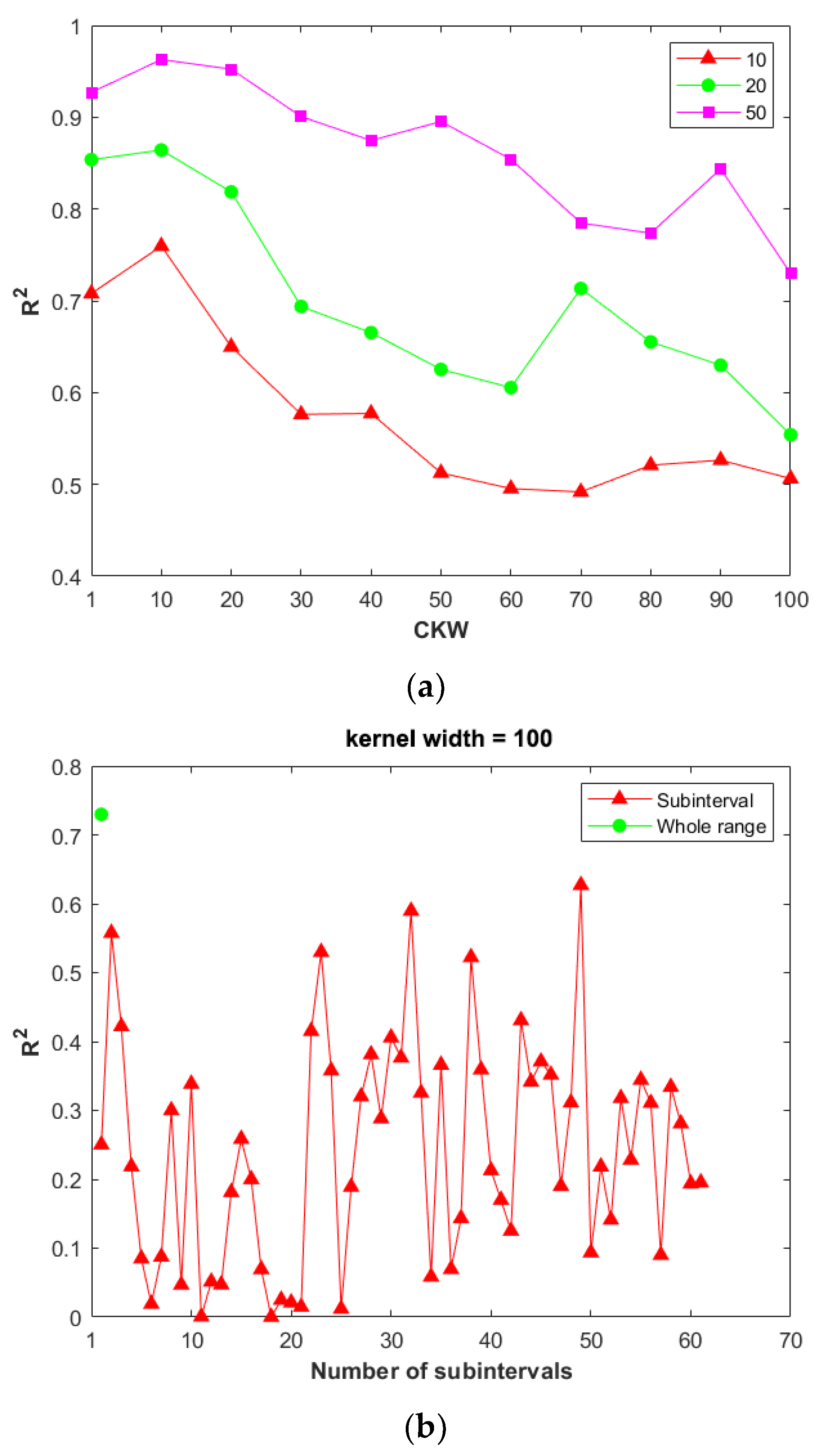
- 2.
- Effect of NCK on the Generalizability of the Prediction Model
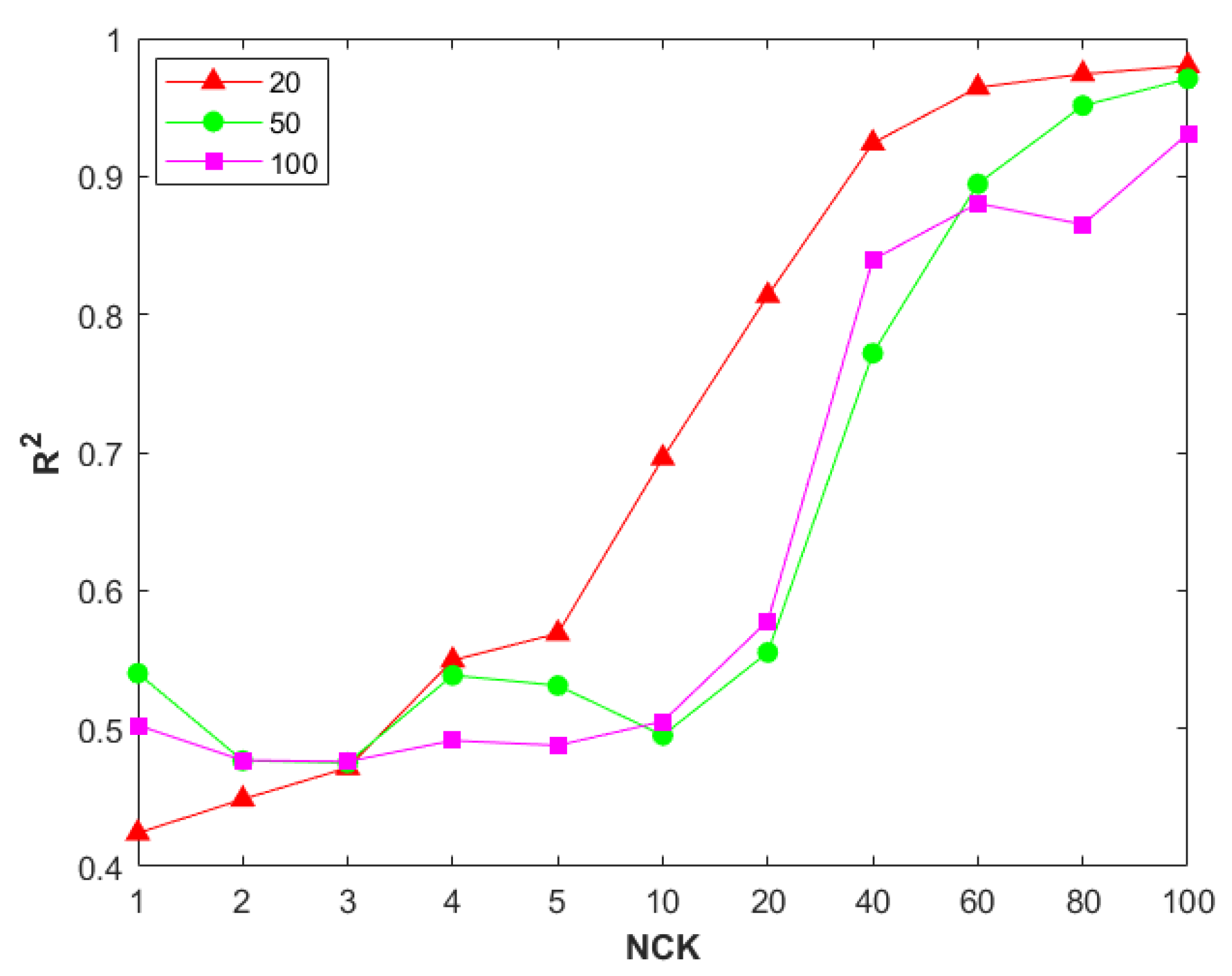
- 3.
- Effect of Stride Step on the Generalizability of the Prediction Model
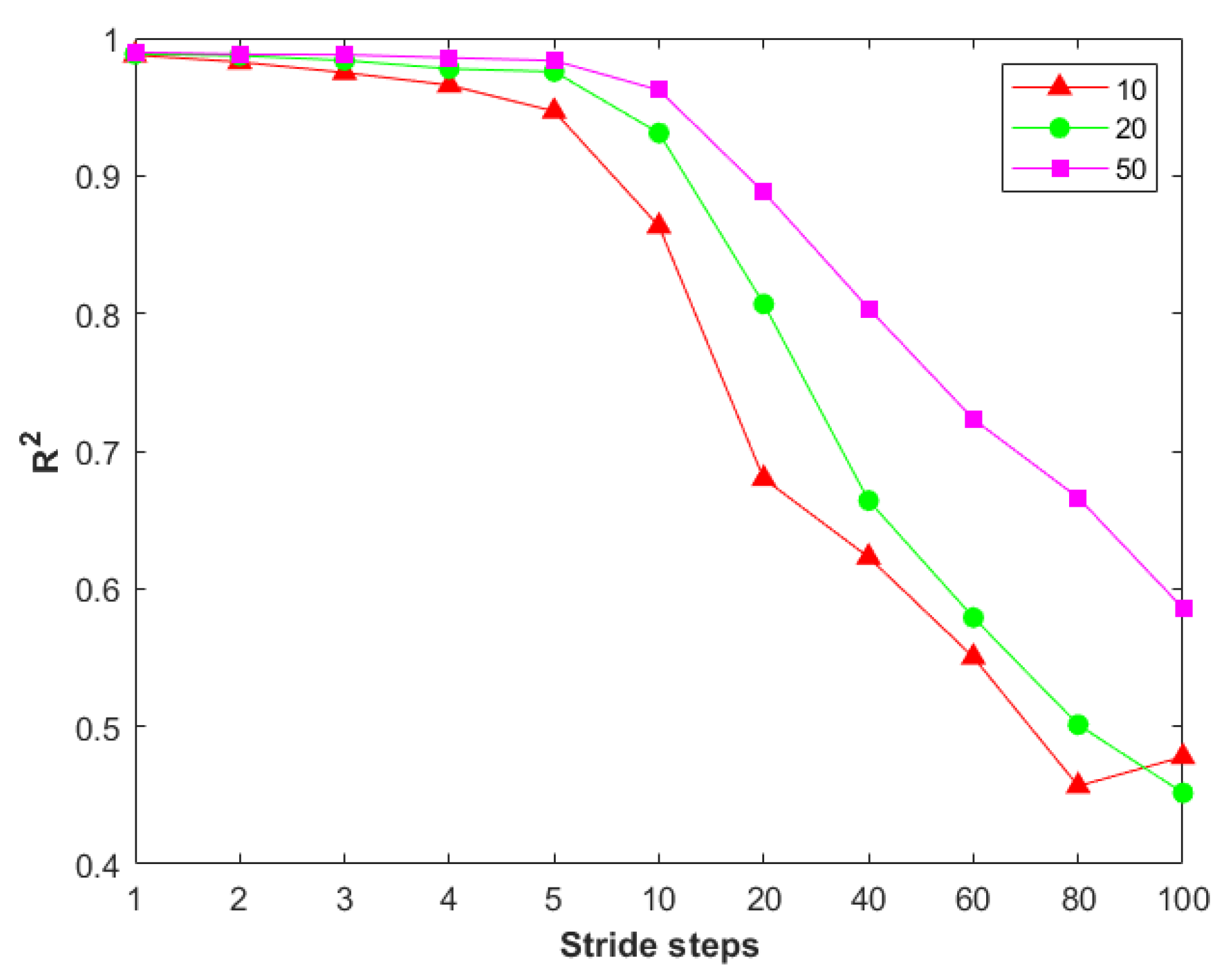
- 4.
- Effect of Mini-Batch Size on the Generalizability of the Prediction Model
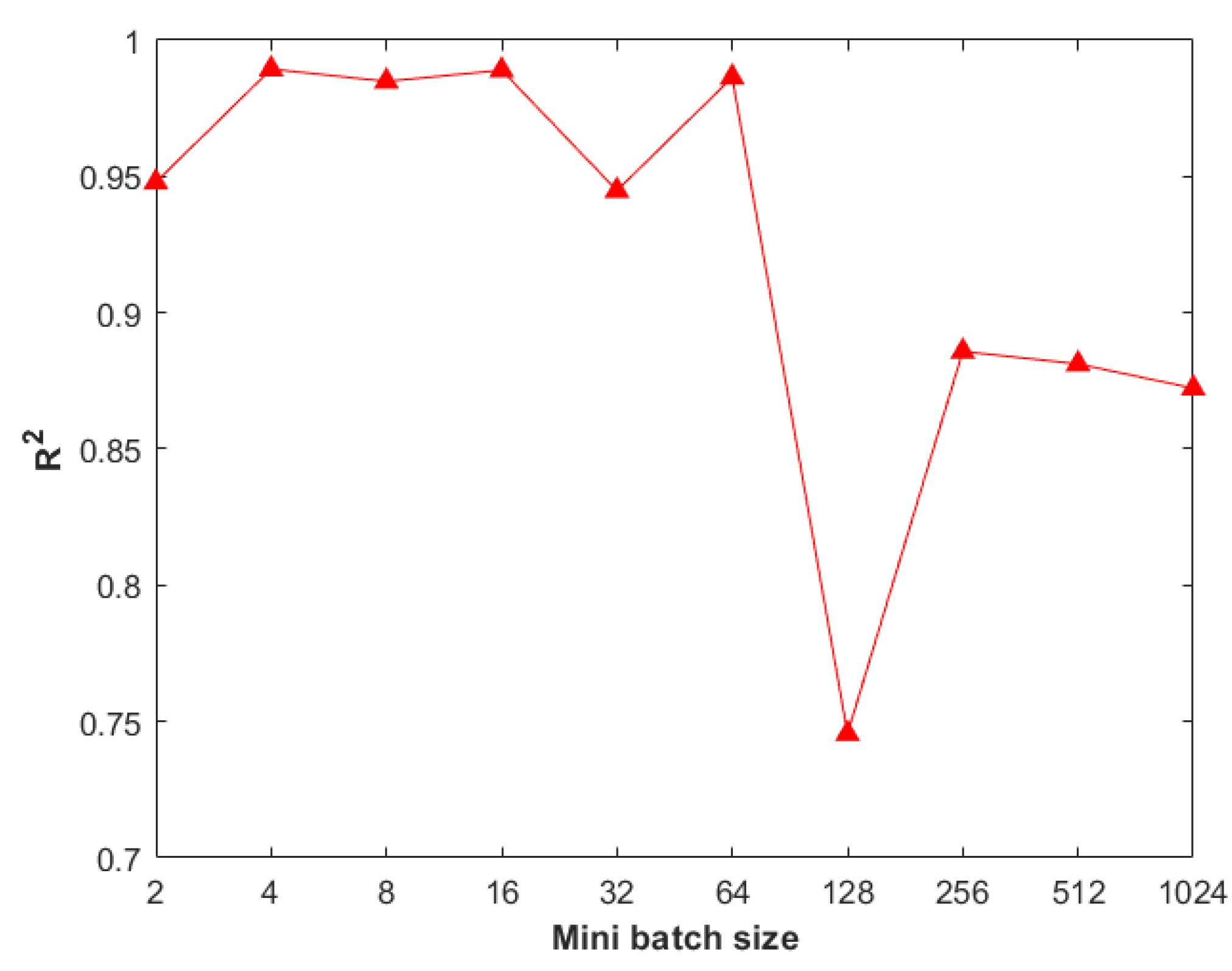
- 5.
- Paradigm for the Overall Design of CNN Parameters
- (1)
- The CKW should not be too small. If the CKW is too small, the convolution kernel extracts the characteristics in some subintervals that are not near the characteristic spectral line, and the model constructed based on these features usually has poor generalization performance. When the CKW is moderate, each feature captured by the convolution kernel contains spectral information near the characteristic spectral line, and the model constructed from these features usually has good generalization performance.
- (2)
- The NCK should not be too large. When the CKW is small, the number of features captured by a single convolution kernel is relatively large. In this case, if the NCK is continuously increased, the total number of features captured by all the convolution kernels will double, and the number of features will vastly exceed the number of samples, causing overfitting and a gradual decrease in the model’s predictive performance. In contrast, when the CKW is large, the model’s predictive performance increases, and after the NCK reaches a threshold value, further increasing the NCK slightly reduces the model’s predictive performance. Therefore, a higher NCK value is not necessarily better. When the CKW value is appropriate, the NCK should not exceed 60.
- (3)
- The stride step should be smaller than the CKW. When the stride step is small, more characteristics can be captured, which helps enhance the model’s prediction ability.
References
- Caceres, J.O.; Sainz de los Terreros, J.Y. A real-world approach to identifying animal bones and Lower Pleistocene fossils by laser induced breakdown spectroscopy. Talanta 2021, 235, 122780. [Google Scholar] [CrossRef] [PubMed]
- Li, L.-N.; Liu, X.-F.; Yang, F.; Xu, W.-M.; Wang, J.-Y.; Shu, R. A review of artificial neural network based chemometrics applied in laser-induced breakdown spectroscopy analysis. Spectrochim. Acta Part B-At. Spectrosc. 2021, 180, 106183. [Google Scholar] [CrossRef]
- Guo, K.-C.; Wu, Z.-C.; Zhu, X.-P.; Ling, Z.-C.; Zhang, J.; Li, Y.; Qian, M.-C. Mineral element abundance identification based on libs emission line selection by loading space distance of principal component analysis. Acta Photonica Sin. 2019, 48, 1030002. [Google Scholar] [CrossRef]
- Chen, S.; Pei, H.; Pisonero, J.; Yang, S.; Fan, Q.; Wang, X.; Duan, Y. Simultaneous determination of lithology and major elements in rocks using laser-induced breakdown spectroscopy (LIBS) coupled with a deep convolutional neural network. J. Anal. At. Spectrom. 2022, 37, 508–516. [Google Scholar] [CrossRef]
- Fabre, C.; Ourti, N.E.; Ballouard, C.; Mercadier, J.; Cauzid, J. Handheld LIBS analysis for in situ quantification of Li and detection of the trace elements (Be, Rb and Cs). J. Geochem. Explor. 2022, 236, 106979. [Google Scholar] [CrossRef]
- Yu, Y.; Yao, M.; Huang, J. A hybrid wavelength selection strategy-based quantitative analysis model for LIBS data from standard ground samples of the Curiosity rover on Mars. J. Anal. At. Spectrom. 2022, 37, 2362–2376. [Google Scholar] [CrossRef]
- Zhang, Y.; Huang, J.; Zhang, Q.; Liu, J.; Meng, Y.; Yu, Y. Nondestructive determination of SSC in an apple by using a portable near-infrared spectroscopy system. Appl. Opt. 2022, 61, 3419–3428. [Google Scholar] [CrossRef] [PubMed]
- El Haddad, J.; Bruyere, D.; Ismael, A.; Gallou, G.; Laperche, V.; Michel, K.; Canioni, L.; Bousquet, B. Application of a series of artificial neural networks to on-site quantitative analysis of lead into real soil samples by laser induced breakdown spectroscopy. Spectrochim. Acta Part B-At. Spectrosc. 2014, 97, 57–64. [Google Scholar] [CrossRef]
- Cui, W.; Hao, Y.; Xu, X.; Feng, Z.; Zhao, H.; Xia, C.; Wang, J. Remote Sensing Scene Graph and Knowledge Graph Matching with Parallel Walking Algorithm. Remote Sens. 2022, 14, 4872. [Google Scholar] [CrossRef]
- Song, W.; Afgan, M.S.; Yun, Y.-H.; Wang, H.; Cui, J.; Gu, W.; Hou, Z.; Wang, Z. Spectral knowledge-based regression for laser-induced breakdown spectroscopy quantitative analysis. Expert Syst. Appl. 2022, 205, 117756. [Google Scholar] [CrossRef]
- Ge, Y.; Zhang, X.; Atkinson, P.M.; Stein, A.; Li, L. Geoscience-aware deep learning: A new paradigm for remote sensing. Sci. Remote Sens. 2022, 5, 100047. [Google Scholar] [CrossRef]
- Hsu, C.-Y.; Li, W.; Wang, S. Knowledge-driven GeoAI: Integrating spatial knowledge into multi-scale deep learning for Mars Crater detection. Remote Sens. 2021, 13, 2116. [Google Scholar] [CrossRef]
- Chen, Y.Y.; Wang, Z.B. End-to-end quantitative analysis modeling of near-infrared spectroscopy based on convolutional neural network. J. Chemom. 2019, 33, e3122. [Google Scholar] [CrossRef]
- Ng, W.; Minasny, B.; Montazerolghaem, M.; Padarian, J.; Ferguson, R.; Bailey, S.; McBratney, A.B. Convolutional neural network for simultaneous prediction of several soil properties using visible/near-infrared, mid-infrared, and their combined spectra. Geoderma 2019, 352, 251–267. [Google Scholar] [CrossRef]
- Cai, Y.; Li, S.; Yao, Z.; Li, T.; Wang, Q. Online detection of concentrate grade in the antimony flotation process based on in situ Raman spectroscopy combined with a CNN-GRU hybrid model. Spectrochim. Acta Part A Mol. Biomol. Spectrosc. 2023, 301, 122909. [Google Scholar] [CrossRef]
- Xueqiang, C.; Zhang, L.; Zhongchen, W.; Zongcheng, L.; Jialun, L.; Kaichen, G. Quantitative analysis modeling for the ChemCam spectral data based on laser-induced breakdown spectroscopy using convolutional neural network. Plasma Sci. Technol. 2020, 22, 115502. [Google Scholar]
- Pengfei, Z.; Ting, Z.; Daohua, X.; Li, Z. Quantitative analysis research of ChemCam-LIBS spectral data of Curiosity rover. Infrared Laser Eng. 2022, 51, 323–332. [Google Scholar]
- Li, L.-N.; Liu, X.-F.; Xu, W.-M.; Wang, J.-Y.; Shu, R. A laser-induced breakdown spectroscopy multi-component quantitative analytical method based on a deep convolutional neural network. Spectrochim. Acta Part B At. Spectrosc. 2020, 169, 105850. [Google Scholar] [CrossRef]
- Chen, Y.-Y.; Wang, Z.-B. Quantitative analysis modeling of infrared spectroscopy based on ensemble convolutional neural networks. Chemom. Intell. Lab. Syst. 2018, 181, 1–10. [Google Scholar] [CrossRef]
- Chen, Y.-Y.; Wang, Z.-B. Feature selection based convolutional neural network pruning and its application in calibration modeling for NIR spectroscopy. Chemom. Intell. Lab. Syst. 2019, 191, 103–108. [Google Scholar] [CrossRef]
- Yu, Y.; Huang, J.; Liu, S.; Zhu, J.; Liang, S. Cross target attributes and sample types quantitative analysis modeling of near-infrared spectroscopy based on instance transfer learning. Measurement 2021, 177, 109340. [Google Scholar] [CrossRef]
- Wang, W.; Zhao, D.; Jiang, Z. Oil Tank Detection via Target-driven Learning Saliency Model. In Proceedings of the 4th IAPR Asian Conference on Pattern Recognition (ACPR), Nanjing, China, 26–29 November 2017; IEEE: Piscataway, NJ, USA; pp. 156–161. [Google Scholar]
- Fang, Y.; Yang, H.; Zhang, X.; Liu, H.; Tao, B. Multi-Feature Input Deep Forest for EEG-Based Emotion Recognition. Front. Neurorobotics 2021, 14, 617531. [Google Scholar] [CrossRef]
- Zhang, J.; Yan, H.; Xiong, Y.; Li, Q.; Min, S. An ensemble variable selection method for vibrational spectroscopic data analysis. RSC Adv. 2019, 9, 6708–6716. [Google Scholar] [CrossRef] [PubMed]
- Shan, P.; Zhao, Y.; Wang, Q.; Sha, X.; Lv, X.; Peng, S.; Ying, Y. Stacked ensemble extreme learning machine coupled with Partial Least Squares-based weighting strategy for nonlinear multivariate calibration. Spectrochim. Acta Part A-Mol. Biomol. Spectrosc. 2019, 215, 97–111. [Google Scholar] [CrossRef]
- Bian, X.; Diwu, P.; Liu, Y.; Liu, P.; Li, Q.; Tan, X. Ensemble calibration for the spectral quantitative analysis of complex samples. J. Chemom. 2018, 32, e2940. [Google Scholar] [CrossRef]
- Pan, X.; Li, Y.; Wu, Z.; Zhang, Q.; Zheng, Z.; Shi, X.; Qiao, Y. A Online NIR Sensor for the Pilot-Scale Extraction Process in Fructus Aurantii Coupled with Single and Ensemble Methods. Sensors 2015, 15, 8749–8763. [Google Scholar] [CrossRef] [PubMed]
- Zhou, Z.; Li, Y.; Zhang, Q.; Shi, X.; Wu, Z.; Qiao, Y. Comparison of Ensemble Strategies in Online NIR for Monitoring the Extraction Process of Pericarpium Citri Reticulatae Based on Different Variable Selections. Planta Med. 2016, 82, 154–162. [Google Scholar] [CrossRef]
- Bi, Y.; Xie, Q.; Peng, S.; Tang, L.; Hu, Y.; Tan, J.; Zhao, Y.; Li, C. Dual stacked partial least squares for analysis of near-infrared spectra. Anal. Chim. Acta 2013, 792, 19–27. [Google Scholar] [CrossRef]
- Raju, S.M.T.U.; Sarker, A.; Das, A.; Islam, M.M.; Al-Rakhami, M.S.; Al-Amri, A.M.; Mohiuddin, T.; Albogamy, F.R. An Approach for Demand Forecasting in Steel Industries Using Ensemble Learning. Complexity 2022, 2022, 1–19. [Google Scholar] [CrossRef]
- Yu, Y.; Huang, J.; Zhu, J.; Liang, S. An Accurate Noninvasive Blood Glucose Measurement System Using Portable Near-Infrared Spectrometer and Transfer Learning Framework. IEEE Sens. J. 2021, 21, 3506–3519. [Google Scholar] [CrossRef]
- Wiens, R.; Maurice, S.; Lasue, J.; Forni, O.; Anderson, R.; Clegg, S.; Bender, S.; Blaney, D.; Barraclough, B.; Cousin, A. Pre-flight calibration and initial data processing for the ChemCam laser-induced breakdown spectroscopy instrument on the Mars Science Laboratory rover. Spectrochim. Acta Part B At. Spectrosc. 2013, 82, 1–27. [Google Scholar] [CrossRef]
- Clegg, S.M.; Wiens, R.C.; Anderson, R.; Forni, O.; Frydenvang, J.; Lasue, J.; Cousin, A.; Payre, V.; Boucher, T.; Dyar, M.D. Recalibration of the Mars Science Laboratory ChemCam instrument with an expanded geochemical database. Spectrochim. Acta Part B At. Spectrosc. 2017, 129, 64–85. [Google Scholar] [CrossRef]
- Zhang, X.; Xu, J.; Yang, J.; Chen, L.; Zhou, H.; Liu, X.; Li, H.; Lin, T.; Ying, Y. Understanding the learning mechanism of convolutional neural networks in spectral analysis. Anal. Chim. Acta 2020, 1119, 41–51. [Google Scholar] [CrossRef] [PubMed]
- Acquarelli, J.; van Laarhoven, T.; Gerretzen, J.; Tran, T.N.; Buydens, L.M.C.; Marchiori, E. Convolutional neural networks for vibrational spectroscopic data analysis. Anal. Chim. Acta 2017, 954, 22–31. [Google Scholar] [CrossRef]
- Yu, Y.; Yao, M. Is this pear sweeter than this apple? A universal SSC model for fruits with similar physicochemical properties. Biosyst. Eng. 2023, 226, 116–131. [Google Scholar] [CrossRef]
- Xie, W.; Wei, S.; Zheng, Z.; Yang, D. A CNN-based lightweight ensemble model for detecting defective carrots. Biosyst. Eng. 2021, 208, 287–299. [Google Scholar] [CrossRef]
- He, C.; Wang, D.; Yu, Y.; Cai, Z. A Hybrid Deep Learning Model for Link Dynamic Vehicle Count Forecasting with Bayesian Optimization. J. Adv. Transp. 2023, 2023, 287–299. [Google Scholar] [CrossRef]
- Hu, Y.; Peng, S.; Peng, J.; Wei, J. An improved ensemble partial least squares for analysis of near-infrared spectra. Talanta 2012, 94, 301–307. [Google Scholar] [CrossRef]
- Breiman, L. Bagging predictors. Mach. Learn. 1996, 24, 123–140. [Google Scholar] [CrossRef]
- Castro, J.P.; Babos, D.V.; Pereira-Filho, E.R. Calibration strategies for the direct determination of rare earth elements in hard disk magnets using laser-induced breakdown spectroscopy. Talanta 2020, 208, 120443. [Google Scholar] [CrossRef]
- Kang, B.; Park, I.; Ok, C.; Kim, S. ODPA-CNN: One Dimensional Parallel Atrous Convolution Neural Network for Band-Selective Hyperspectral Image Classification. Appl. Sci. 2022, 12, 174. [Google Scholar] [CrossRef]
- Xu, L.; Zhu, D.; Chen, X.; Li, L.; Huang, G.; Yuan, L. Combination of one-dimensional convolutional neural network and negative correlation learning on spectral calibration. Chemom. Intell. Lab. Syst. 2020, 199, 103954. [Google Scholar] [CrossRef]
- Alix, G.; Lymer, E.; Zhang, G.; Daly, M.; Gao, X. A comparative performance of machine learning algorithms on laser-induced breakdown spectroscopy data of minerals. J. Chemom. 2022, e3400. [Google Scholar] [CrossRef]
- Zhao, Y.-P.; Chen, Y.-B. Extreme learning machine based transfer learning for aero engine fault diagnosis. Aerosp. Sci. Technol. 2022, 121, 107311. [Google Scholar] [CrossRef]
- Ng, W.; Minasny, B.; McBratney, A. Convolutional neural network for soil microplastic contamination screening using infrared spectroscopy. Sci. Total Environ. 2020, 702, 134723. [Google Scholar] [CrossRef]
- Chen, J.; Pisonero, J.; Chen, S.; Wang, X.; Fan, Q.; Duan, Y. Convolutional neural network as a novel classification approach for laser-induced breakdown spectroscopy applications in lithological recognition. Spectrochim. Acta Part B At. Spectrosc. 2020, 166, 105801. [Google Scholar] [CrossRef]
- Sun, S.; Huang, J.; Zhu, J.; Yu, Y.; Zheng, L. Research on Both the Classification and Quality Control Methods of the Car Seat Backrest Based on Machine Vision. Wirel. Commun. Mob. Comput. 2022, 2022, 1–11. [Google Scholar] [CrossRef]
- Bian, X. Deep Learning Methods. In Chemometric Methods in Analytical Spectroscopy Technology; Springer: Berlin/Heidelberg, Germany, 2022; pp. 503–553. [Google Scholar]
- Wu, N.; Zhang, Y.; Na, R.; Mi, C.; Zhu, S.; He, Y.; Zhang, C. Variety identification of oat seeds using hyperspectral imaging: Investigating the representation ability of deep convolutional neural network. RSC Adv. 2019, 9, 12635–12644. [Google Scholar] [CrossRef]
- Qiu, Z.; Chen, J.; Zhao, Y.; Zhu, S.; He, Y.; Zhang, C. Variety Identification of Single Rice Seed Using Hyperspectral Imaging Combined with Convolutional Neural Network. Appl. Sci. 2018, 8, 212. [Google Scholar] [CrossRef]
- Venturini, F.; Michelucci, U.; Sperti, M.; Gucciardi, A.; Deriu, M.A. One-dimensional convolutional neural networks design for fluorescence spectroscopy with prior knowledge: Explainability techniques applied to olive oil fluorescence spectra. In Proceedings of the Optical Sensing and Detection VII, Strasbourg, France, 17 May 2022; pp. 326–333. [Google Scholar]
- Wang, C.-Y.; Ko, T.-S.; Hsu, C.-C. Interpreting convolutional neural network for real-time volatile organic compounds detection and classification using optical emission spectroscopy of plasma. Anal. Chim. Acta 2021, 1179, 338822. [Google Scholar] [CrossRef]
- Melikechi, N.; Mezzacappa, A.; Cousin, A.; Lanza, N.L.; Lasue, J.; Clegg, S.M.; Berger, G.; Wiens, R.C.; Maurice, S.; Tokar, R.L.; et al. Correcting for variable laser-target distances of laser-induced breakdown spectroscopy measurements with ChemCam using emission lines of Martian dust spectra. Spectrochim. Acta Part B-At. Spectrosc. 2014, 96, 51–60. [Google Scholar] [CrossRef]
- Wiens, R.C.; Blazon-Brown, A.J.; Melikechi, N.; Frydenvang, J.; Dehouck, E.; Clegg, S.M.; Delapp, D.; Anderson, R.B.; Cousin, A.; Maurice, S. Improving ChemCam LIBS long-distance elemental compositions using empirical abundance trends. Spectrochim. Acta Part B-At. Spectrosc. 2021, 182, 106247. [Google Scholar] [CrossRef]
- Yang, W.; Xiao, Y.; Shen, H.; Wang, Z. An effective data enhancement method of deep learning for small weld data defect identification. Measurement 2023, 206, 112245. [Google Scholar] [CrossRef]
- Tan, A.; Wang, Y.; Zhao, Y.; Zuo, Y. 1D-Inception-Resnet for NIR quantitative analysis and its transferability between different spectrometers. Infrared Phys. Technol. 2023, 129, 104559. [Google Scholar] [CrossRef]
- Zhu, Q.-X.; Gong, H.-F.; Xu, Y.; He, Y.-L. A bootstrap based virtual sample generation method for improving the accuracy of modeling complex chemical processes using small datasets. In Proceedings of the 2017 6th Data Driven Control and Learning Systems (DDCLS), Chongqing, China, 26–27 May 2017; pp. 84–88. [Google Scholar]
- Yu, Y.; Zhang, Q.; Huang, J.; Zhu, J.; Liu, J. Nondestructive determination of SSC in Korla fragrant pear using a portable near-infrared spectroscopy system. Infrared Phys. Technol. 2021, 116, 103785. [Google Scholar] [CrossRef]
- Xu, J.-l.; Liu, H.; Lin, C.-b.; Sun, Q. SNR analysis and Hadamard mask modification of DMD Hadamard Transform Near-Infrared spectrometer. Opt. Commun. 2017, 383, 250–254. [Google Scholar] [CrossRef]
- Mishra, P.; Passos, D. Multi-output 1-dimensional convolutional neural networks for simultaneous prediction of different traits of fruit based on near-infrared spectroscopy. Postharvest Biol. Technol. 2022, 183, 111741. [Google Scholar] [CrossRef]
- Dong, H.; Sun, L.; Qi, L.; Yu, H.; Zeng, P. A lightweight convolutional neural network model for quantitative analysis of phosphate ore slurry based on laser-induced breakdown spectroscopy. J. Anal. At. Spectrom. 2021, 36, 2528–2535. [Google Scholar] [CrossRef]

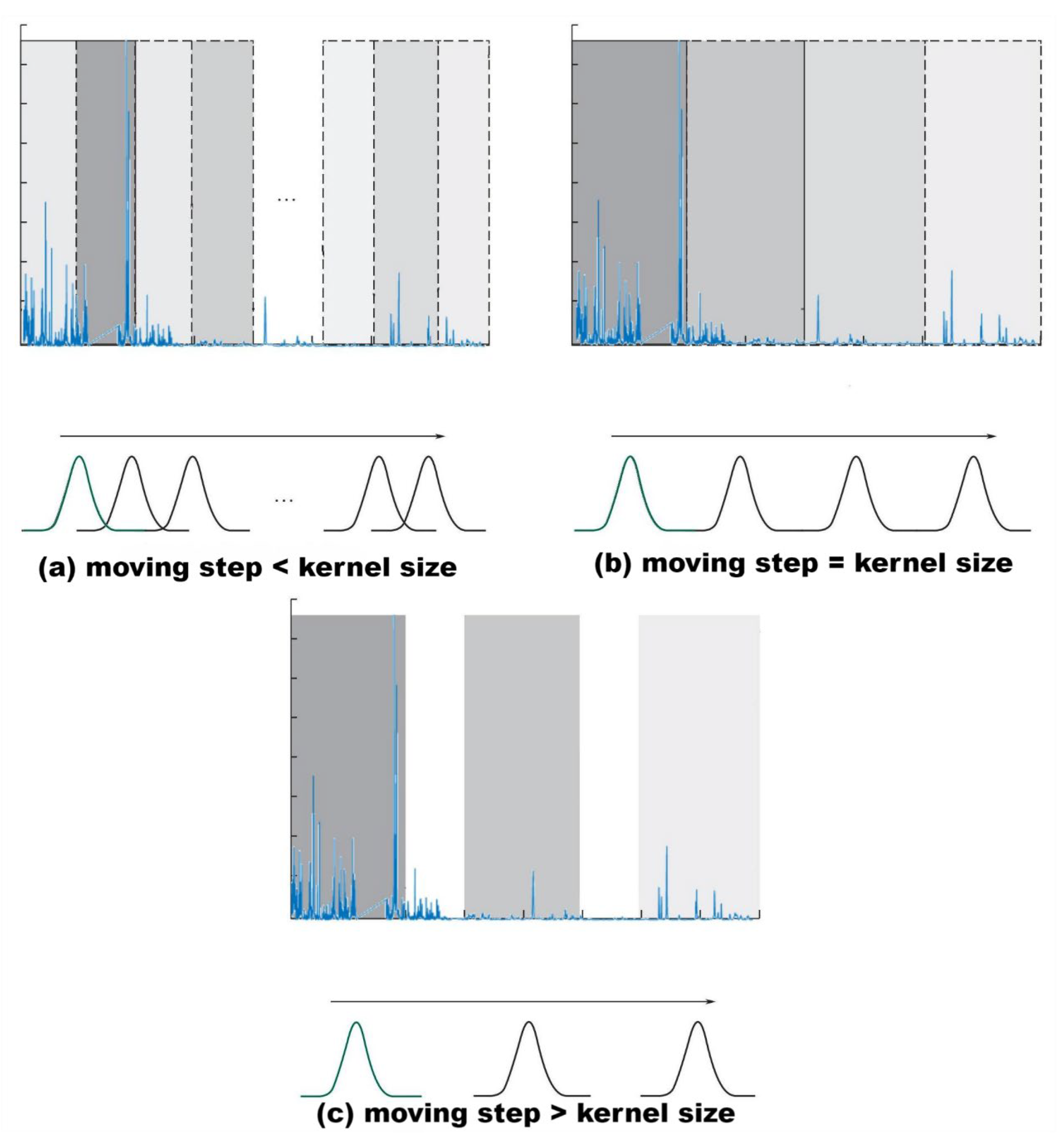
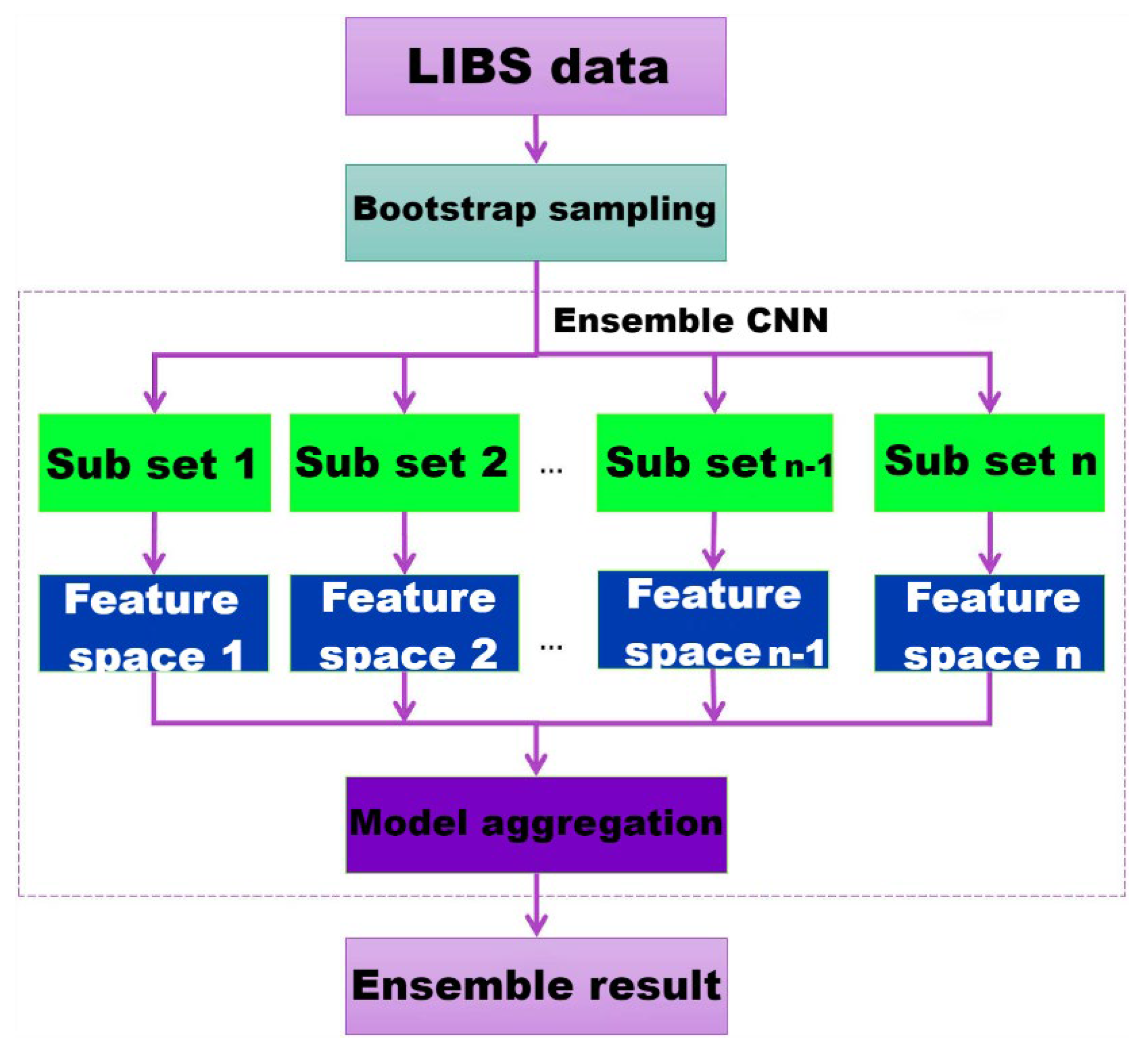
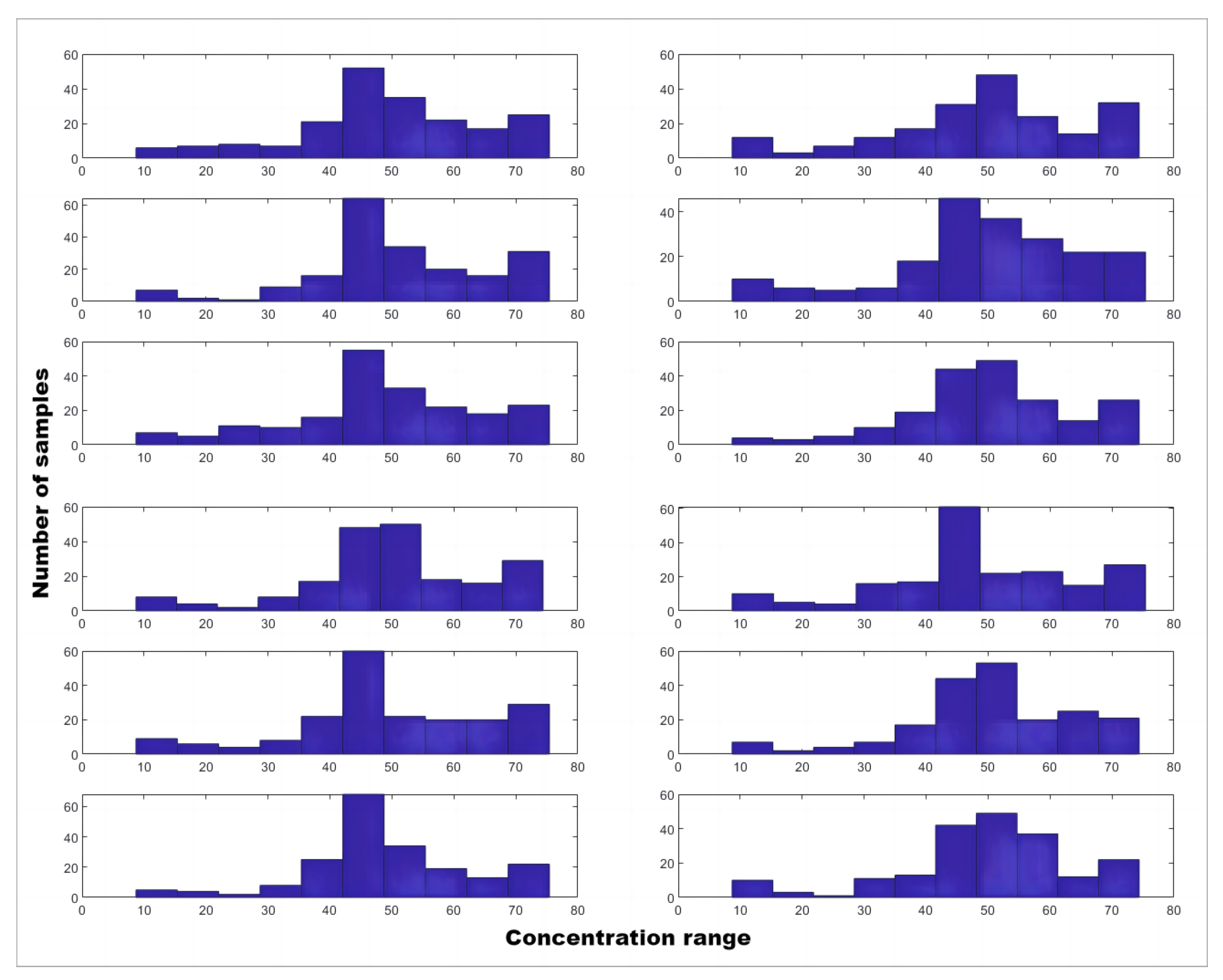

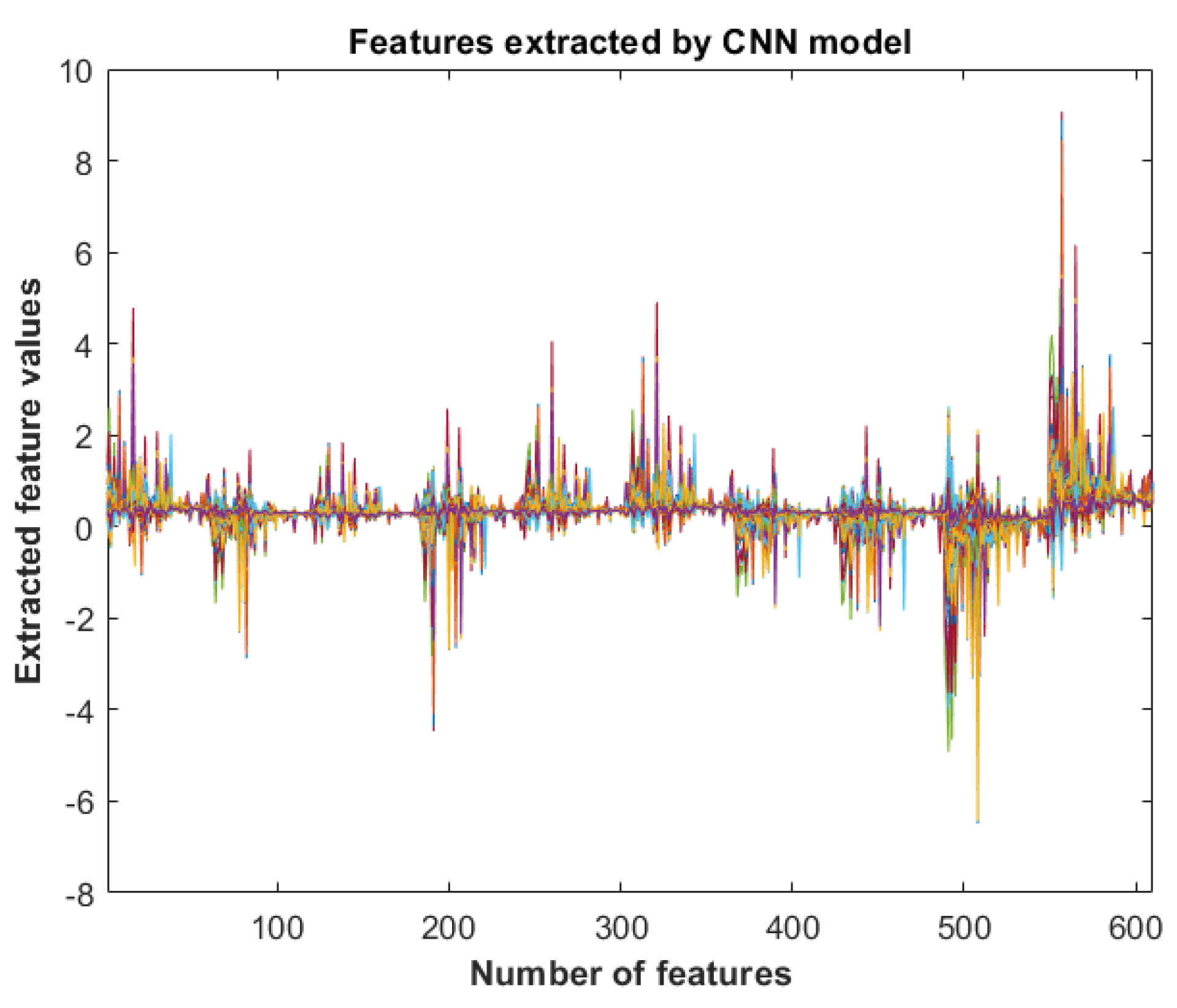

| Element | Set | No. of Samples | Concentration, wt% | |
|---|---|---|---|---|
| Range | Mean ± STD 1 | |||
| Original calibration dataset | ||||
| Si | Calibration | 200 | 8.70–75.41 | 49.46 ± 14.84 |
| Prediction | 40 | 30.90–75.41 | 54.20 ± 13.35 | |
| Al | Calibration | 200 | 0.17–23.71 | 11.56 ± 5.95 |
| Prediction | 40 | 0.17–23.71 | 10.93 ± 5.11 | |
| K | Calibration | 200 | 0.03–5.60 | 1.33 ± 1.37 |
| Prediction | 40 | 0.05–5.43 | 1.56 ± 1.63 | |
| Expanded calibration dataset | ||||
| Si | Calibration | 1435 | 0.21–84.90 | 55.99 ± 14.38 |
| Prediction | 287 | 0.21–84.63 | 56.35 ± 13.65 | |
| Al | Calibration | 1435 | 0.01–38.79 | 15.48 ± 5.84 |
| Prediction | 287 | 0.01–38.79 | 16.43 ± 5.91 | |
| K | Calibration | 1435 | 0.002–12.05 | 2.51 ± 1.89 |
| Prediction | 287 | 0.002–12.05 | 2.22 ± 1.89 | |
| Element | Model | Calibration | Prediction | ||
|---|---|---|---|---|---|
| Rc2 | RMSECV | Rp2 | RMSEP | ||
| Original calibration dataset | |||||
| Si | PLS | 0.9787 | 2.1614 | 0.9554 | 2.9609 |
| ELM | 0.8376 ± 0.0487 | 5.9013 ± 0.8821 | 0.7601 ± 0.0360 | 6.9684 ± 0.5136 | |
| CNN | 0.9789 ± 0.0071 | 2.2148 ± 0.3184 | 0.9724 ± 0.0173 | 2.2099 ± 0.6013 | |
| ECNN1 | 0.9899 ± 0.0034 | 1.5561 ± 0.2847 | 0.9848 ± 0.0031 | 1.6728 ± 0.1759 | |
| C-QuEST | 0.9695 | 2.5846 | 0.9287 | 3.7354 | |
| Al | PLS | 0.9837 | 0.7579 | 0.9540 | 1.1499 |
| ELM | 0.8795 ± 0.0228 | 2.0529 ± 0.1909 | 0.7614 ± 0.0384 | 2.5271 ± 0.2042 | |
| CNN | 0.9869 ± 0.0059 | 0.6983 ± 0.1235 | 0.9768 ± 0.0126 | 0.8326 ± 0.1841 | |
| ECNN1 | 0.9927 ± 0.0020 | 0.5799 ± 0.0431 | 0.9868 ± 0.0015 | 0.6785 ± 0.0898 | |
| C-QuEST | 0.9577 | 1.2220 | 0.8862 | 1.8028 | |
| K | PLS | 0.9768 | 0.2079 | 0.9636 | 0.3280 |
| ELM | 0.8272 ± 0.0329 | 0.5651 ± 0.0555 | 0.7895 ± 0.0400 | 0.7746 ± 0.0906 | |
| CNN | 0.9813 ± 0.0079 | 0.2134 ± 0.0411 | 0.9632 ± 0.0536 | 0.3345 ± 0.1275 | |
| ECNN1 | 0.9885 ± 0.0039 | 0.1907 ± 0.0447 | 0.9834 ± 0.0028 | 0.2545 ± 0.0374 | |
| C-QuEST | 0.9605 | 0.2714 | 0.8714 | 0.6057 | |
| Expanded calibration dataset | |||||
| Si | PLS | 0.8888 | 4.6200 | 0.8839 | 4.8997 |
| ELM | 0.8861 ± 0.0743 | 4.6073 ± 1.4011 | 0.8751 ± 0.0831 | 4.7240 ± 1.3965 | |
| CNN | 0.9163 ± 0.0851 | 3.8111 ± 1.6685 | 0.9053 ± 0.0942 | 3.8803 ± 1.6132 | |
| ECNN1 | 0.9345 ± 0.0608 | 3.4640 ± 1.2408 | 0.9270 ± 0.0669 | 3.4894 ± 1.1912 | |
| ECNN2 | 0.9616 ± 0.0022 | 2.8140 ± 0.0825 | 0.9524 ± 0.0012 | 2.9782 ± 0.0398 | |
| Al | PLS | 0.8578 | 2.2083 | 0.8572 | 2.2395 |
| ELM | 0.8638 ± 0.0651 | 2.1042 ± 0.4747 | 0.8596 ± 0.0713 | 2.1729 ± 0.5160 | |
| CNN | 0.8787 ± 0.0843 | 1.9536 ± 0.5737 | 0.8661 ± 0.1264 | 2.0313 ± 0.7457 | |
| ECNN1 | 0.9095 ± 0.0458 | 1.7129 ± 0.3973 | 0.9065 ± 0.0507 | 1.7604 ± 0.4131 | |
| ECNN2 | 0.9498 ± 0.0036 | 1.3087 ± 0.0483 | 0.9436 ± 0.0013 | 1.4042 ± 0.0167 | |
| K | PLS | 0.8608 | 0.7065 | 0.8614 | 0.7069 |
| ELM | 0.8446 ± 0.0722 | 0.7277 ± 0.1660 | 0.8301 ± 0.0671 | 0.7669 ± 0.1480 | |
| CNN | 0.9034 ± 0.0816 | 0.5453 ± 0.2214 | 0.8924 ± 0.0934 | 0.5713 ± 0.2371 | |
| ECNN1 | 0.9348 ± 0.0578 | 0.4490 ± 0.1788 | 0.9271 ± 0.0671 | 0.4706 ± 0.1934 | |
| ECNN2 | 0.9687 ± 0.0011 | 0.3349 ± 0.0062 | 0.9645 ± 0.0020 | 0.3550 ± 0.0103 | |
| Element | CCCT Name | Actuals | ECNN2 | CNN | ELM | PLS | ||||
|---|---|---|---|---|---|---|---|---|---|---|
| Predicted | RER | Predicted | RER | Predicted | RER | Predicted | RER | |||
| Si | Norite | 47.88 | 47.19 | 1.42% | 46.69 | 2.45% | 46.61 | 2.63% | 46.24 | 3.40% |
| Picrite | 43.59 | 44.08 | 1.14% | 42.05 | 3.50% | 41.28 | 5.27% | 40.34 | 7.42% | |
| Shergottite | 48.42 | 48.30 | 0.23% | 46.63 | 3.69% | 45.70 | 5.60% | 45.17 | 6.55% | |
| NAU2-LO-S | 43.78 | 43.70 | 0.17% | 45.02 | 2.85% | 47.00 | 7.37% | 48.23 | 10.17% | |
| NAU2-MED-S | 37.48 | 38.54 | 2.83% | 40.31 | 7.54% | 33.42 | 10.82% | 41.71 | 11.29% | |
| KGA-MED-S | 35.64 | 36.99 | 3.79% | 38.57 | 8.23% | 42.40 | 18.96% | 42.57 | 19.46% | |
| Al | Norite | 14.66 | 15.01 | 2.33% | 15.57 | 6.34% | 16.22 | 10.72% | 12.50 | 14.78% |
| Picrite | 12.39 | 12.86 | 3.81% | 14.02 | 13.12% | 15.32 | 23.62% | 15.52 | 25.25% | |
| Shergottite | 10.83 | 11.50 | 6.16% | 12.30 | 13.77% | 12.35 | 14.07% | 12.48 | 15.27% | |
| NAU2-LO-S | 7.63 | 7.69 | 0.80% | 7.83 | 2.63% | 7.06 | 7.34% | 6.85 | 10.10% | |
| NAU2-MED-S | 5.72 | 5.95 | 4.12% | 6.71 | 17.36% | 7.05 | 23.33% | 7.29 | 27.54% | |
| KGA-MED-S | 23.71 | 21.49 | 9.39% | 27.02 | 13.94% | 28.77 | 21.37% | 29.06 | 22.56% | |
| K | Norite | 0.06 | 0.056 | 5.73% | 0.054 | 9.00% | 0.051 | 13.67% | 0.053 | 11.63% |
| Picrite | 0.10 | 0.109 | 9.56% | 0.111 | 11.76% | 0.0732 | 26.80% | 0.129 | 29.66% | |
| Shergottite | 0.11 | 0.114 | 4.38% | 0.103 | 6.31% | 0.143 | 29.97% | 0.100 | 9.12% | |
| NAU2-LO-S | 0.40 | 0.461 | 15.48% | 0.491 | 22.77% | 0.589 | 47.41% | 0.524 | 31.17% | |
| NAU2-MED-S | 0.29 | 0.312 | 7.85% | 0.169 | 41.62% | 0.141 | 51.21% | 0.143 | 50.49% | |
| KGA-MED-S | 0.26 | 0.264 | 1.63% | 0.276 | 6.24% | 0.287 | 10.65% | 0.286 | 10.31% | |
Disclaimer/Publisher’s Note: The statements, opinions and data contained in all publications are solely those of the individual author(s) and contributor(s) and not of MDPI and/or the editor(s). MDPI and/or the editor(s) disclaim responsibility for any injury to people or property resulting from any ideas, methods, instructions or products referred to in the content. |
© 2023 by the authors. Licensee MDPI, Basel, Switzerland. This article is an open access article distributed under the terms and conditions of the Creative Commons Attribution (CC BY) license (https://creativecommons.org/licenses/by/4.0/).
Share and Cite
Yu, Y.; Yao, M. When Convolutional Neural Networks Meet Laser-Induced Breakdown Spectroscopy: End-to-End Quantitative Analysis Modeling of ChemCam Spectral Data for Major Elements Based on Ensemble Convolutional Neural Networks. Remote Sens. 2023, 15, 3422. https://doi.org/10.3390/rs15133422
Yu Y, Yao M. When Convolutional Neural Networks Meet Laser-Induced Breakdown Spectroscopy: End-to-End Quantitative Analysis Modeling of ChemCam Spectral Data for Major Elements Based on Ensemble Convolutional Neural Networks. Remote Sensing. 2023; 15(13):3422. https://doi.org/10.3390/rs15133422
Chicago/Turabian StyleYu, Yan, and Meibao Yao. 2023. "When Convolutional Neural Networks Meet Laser-Induced Breakdown Spectroscopy: End-to-End Quantitative Analysis Modeling of ChemCam Spectral Data for Major Elements Based on Ensemble Convolutional Neural Networks" Remote Sensing 15, no. 13: 3422. https://doi.org/10.3390/rs15133422
APA StyleYu, Y., & Yao, M. (2023). When Convolutional Neural Networks Meet Laser-Induced Breakdown Spectroscopy: End-to-End Quantitative Analysis Modeling of ChemCam Spectral Data for Major Elements Based on Ensemble Convolutional Neural Networks. Remote Sensing, 15(13), 3422. https://doi.org/10.3390/rs15133422







